| |||||||
| Search Forums |
| Advanced Search |
| Go to Page... |
 |
| Search this Thread |  183,150 views |
| | #1 |
| Team-BHP Support  Join Date: Apr 2016 Location: Mumbai
Posts: 1,813
Thanked: 21,569 Times
| Tata Tigor Electric Review Tata Tigor Electric ReviewTata Tigor EV Pros• A competent EV package at an affordable starting price • Zero tailpipe emissions & green image will appeal to the environmentally-conscious • Real-world range of ~200 km is adequate for city commutes & urban dwellers • Stupendously cheap fuel cost of 1 rupee / km (if you charge at home) • Peppy behaviour in "S" mode! "D" mode is rather tame though • Sorted road manners due to the lower center-of-gravity & firmer suspension • Smooth drive, no gears, light controls & compact size make it an ideal city car • Well-designed interiors are likeable & user-friendly • Features like the 8-speaker Harman audio system, projector headlamps, connected car tech & more • Solid build & construction. 4-star GNCAP safety rating is commendable Tata Tigor EV Cons• A stiff 5-lakh rupees more expensive than the Tigor Petrol AMT • Nexon EV is superior & not that far away in terms of pricing (or EMIs) • ~200 km range means this is strictly a city car. No long highway runs • Stiffer suspension than the regular Tigor means you feel more of the road. Bad roads are felt • Power tapers off after 100 km/h; top speed of just 120 km/h • Smaller 316L boot (regular Tigor = 419L) due to the intrusive spare tyre • Some misses such as "P" mode on the shifter, adjustable regen braking & alloy wheels • A rare Tata car that cannot seat 5 (best for 4 adults) • Tata's after-sales service quality is a hit or miss. Remains a gamble • It's a brand-new technology, so there will be issues & niggles This review has been jointly compiled with Aditya & GTO. Thanks to them for the expert observations!  IntroductionTata has been proudly selling India's most affordable "proper" electric car, the Nexon EV for a while now. And it has been rewarded too = in July & August, the company has moved ~600 units of the Nexon EV. More important than that though is how these sales & heavy customer feedback help the company learn more about the game-changing EV technology. To widen its reach, Tata now introduces the even more affordable Tigor EV. Electric vehicles are going mainstream - there's no doubt and this is definitely a sigh of relief for people who are fed up with pollution levels & the rising prices of fossil fuels. Do note this isn’t the first-ever Tigor EV. Back in 2017, Tata Motors won a tender to supply 10,000 Tigor EVs to the government-owned Energy Efficiency Services Limited (EESL), and the car was later made available to select rental services like Zoomcar. However, that was more of a learning experiment. The car you see here is quite different from the previous one and is made specifically keeping the private car owner in mind. The 2021 Tigor EV gets a Permanent Magnet Synchronous motor (instead of an AC induction motor) that puts out 74 BHP & 170 Nm (34 BHP & 65 Nm more), as well as a larger 26 kWh battery pack which gives the car an ARAI-certified range of 306 km (164 km more). You can expect a real-world range of ~200 km. There’s plenty more to talk about the drivetrain, so keep reading. The Tigor EV is offered in 3 trims – XE, XM, XZ+ (with a dual-tone option available in the XZ+ variant) and 2 colour options - Signature Teal Blue (our test car) and Daytona Grey. Tata Tigor EV Price & BrochurePrior to the launch, there were rumours that the Tigor EV would be a sub-10 lakh rupee car. Clearly, that’s not been the case. The Tigor EV has been launched at the following prices; XE - Rs. 11.99 lakh, XM - Rs. 12.49 lakh, XZ+ - Rs. 12.99 lakh and XZ+ Dual Tone - Rs. 13.14 lakh (ex-showroom). Compare these prices with the equivalent petrol-powered variants of the car and there’s obviously a massive difference. Variant to variant, the price premium is ~5.5 lakh (petrol automatic vs electric)! This is a lot & clearly just for early adopters, but for someone who’s looking at an entry-level electric car, the Tigor EV is one of the cheapest options on sale currently. That being said, we will tell you that the Nexon EV is priced not too far away. The Nexon EV XM variant starting @ Rs 13.99 lakhs is totally worth the price difference. It is the superior car. You can download the 2021 Tata Tigor EV brochure here - Tata Tigor EV Brochure.pdf IncentivesApart from the central government's incentives, states are offering additional perks to promote the use of electric vehicles. Maharashtra recently revised its EV policy, which capped the total incentive on electric 4-wheelers at Rs. 2,75,000. This includes a basic incentive of Rs. 1,50,000, an early-bird incentive of Rs. 1,00,000 and a scrappage incentive of Rs. 25,000. Incentives totalling Rs. 1,75,000 will be offered on vehicles purchased after December 31, 2021. Also, the registration and road tax has been waived off on all EVs. Furthermore, income tax benefits are available under section 80EEB (only applicable for vehicles registered by individuals) - click here to read a detailed article on the same. Running CostsGiven the high prices of fossil fuels, the cost of running a vehicle has been a pain point for many. Let’s run down simple math for the Tigor EV. The battery capacity is 26 kWh, which means it will need 26 units of electricity for a 100% charge. The per-unit cost of electricity depends on the slab that you are in & your location, but on average, it’s about Rs. 8 per unit. In this case, you’ll be paying Rs. 208 for a full charge. While the ARAI certified range is 306 km, you can expect a real-life driving range of ~200 km under normal driving conditions. Translated, you’ll be paying just Rs. 1.04 per km which is an incredibly sweet figure. This number feels even more impressive when you consider that the average petrol compact sedan costs you 8 - 9 bucks / km (FE of 12 in the city), while a diesel will cost you 6 - 7 bucks (FE of 15 in the city). Want to know more about EVs?Read GTO's excellent article (Electric Cars...through the eyes of a diehard petrol-head) on the topic. Design & StylingThe Tigor has always been a smart-looking sedan, and there are a few design elements to differentiate the EV variant. For starters, the signature 'Teal Blue' paint shade and black roof are exclusive for the Tigor EV. Then, multiple blue accents at different locations and the 'EV' badges, further remind you that it’s an EV. The best part for owners will be the green number plate, which many wear as a badge of honour! Build Quality, Fit & FinishThe build is solid and the car doesn’t feel flimsy at all. With a kerb weight of 1,235 kilos, the Tigor EV is heavy. The hefty battery pack contributes significantly to its weight. Fit & finish of some of the parts could have been better though. As an example, the blue highlight below the front grille on our test car was slightly misaligned. Then, the ORVM glasses on our test car kept shaking & vibrating over bad roads. The Teal Blue paint, on the other hand, is of good quality and has a nice, glossy finish. Wheels & TyresThe top variant of the regular Tigor is offered with 15-inch alloy wheels wrapped with 175/60 section rubber. The Tigor EV comes with 14-inch steel wheels & 175/65 section tyres. Sadly, no alloy wheels! Our test car was shod with Apollo Amazer XP series rubber, which are low resistance tyres specifically designed for efficiency. The steel wheels are offered with wheel covers that make them look like alloy wheels. No doubt, these 14-inch rims do look small for the size of the car. The Tigor EV is heavier than the regular Tigor by ~200 kg, and since the battery pack is sitting below the boot, there is more weight at the rear. Hence, the recommended pressure for the front tyres is 33 PSI, while that for the rear tyres is 38 PSI. Ground ClearanceTo bear the additional weight, Tata has made changes to the suspension as well. As a result, the Tigor EV has an unladen ground clearance of 172 mm, which is 2 mm more than the regular Tigor. Standard & Extended WarrantyThe Tigor EV is offered with a standard warranty of 3 years / 125,000 km, which is 1 year more than the regular Tigor. Details of the extended warranty haven’t been revealed yet, but you must make an entry in your to-do list and take it (new technology after all). You get an 8 year / 160,000 km warranty on the battery pack and electric motor as standard. MaintenanceThe Tigor EV has a service interval of 6 months / 7,500 km. EV maintenance is far simpler than ICE cars as there are no oil changes & filters to carry out. SafetyThe Tigor EV has scored a commendable 4-stars in the Global NCAP crash tests. The car comes with dual airbags, ABS + EBD + corner stability control, reverse parking camera and sensors, hill descent control and hill ascent assist. Apart from this, the battery pack and motor get an IP67 rating which means they are dustproof & waterproof. Cabin Design & QualityNothing has changed on the inside, except for a small handful of cosmetic bits and feature additions. Tata introduced the dual-tone black & white dashboard with the Tigor facelift and the same is seen on the EV too. The only changes here are the blue accents on the dashboard and the new seat fabric design. Unique & Noteworthy FeaturesThe Tigor EV comes with almost all the features you’d expect in a compact sedan. These include a 7-inch touchscreen head-unit with Android Auto & Apple CarPlay and a digital instrument cluster. You also get iRA (Intelligent Real-time Assist) connected technology, which offers features like intrusion alert, remote immobilization, geofencing, time fencing, remote door lock/unlock, remote cooling, remote vehicle diagnostics, trip analytics etc. Boot SpaceThis is where things have changed drastically compared to the regular Tigor. Since the battery pack is placed under the boot, the spare wheel is actually kept inside the boot on the right-hand side! This noticeably chews away boot space. As a result, the Tigor EV has a 316-litre boot compared to the regular Tigor’s 419-litre unit. Last edited by Aditya : 16th December 2022 at 18:04. |
| |  (56)
Thanks (56)
Thanks
 |
| The following 56 BHPians Thank Omkar for this useful post: | 400notout, Aditya, AdityaDeane, Akshay6988, aman9393, Arnav Vaghela, ashis89, CARDEEP, Carpainter, CEF_Beasts, chinmaypillay, condor, cool_dube, d3thknell, digitalnirvana, drrajasaravanan, Dry Ice, fiat_tarun, FloatingCanvas, frankmehta, frewper, GTO, Hariz066, hemanth.anand, InControl, InterceptorGuy, jailbird_fynix, joshtronic, lemedico, Malluspec, mh09ad5578, NirmalK, ph03n!x, Punatic, RaghuVis, red_nemesis, Researcher, rj22, RohaNN_kWh, romil.shroff, RR96, S.MJet, sainyamk95, sajaijayan, Scarlet_Rider, SnS_12, Sreejith V, sri_tesla, swiftnfurious, theexperthand, The_Outsider!, TorqueIndia, turbodude, vb-saan, Vinod_nair, warrioraks |
| |
| | #2 |
| Team-BHP Support  Join Date: Apr 2016 Location: Mumbai
Posts: 1,813
Thanked: 21,569 Times
| Driving the Tata Tigor EVPermanent Magnet Synchronous Motor puts out 74 BHP & 170 Nm of torque. That's far lower than the Nexon EV's 127 BHP & 245 Nm: 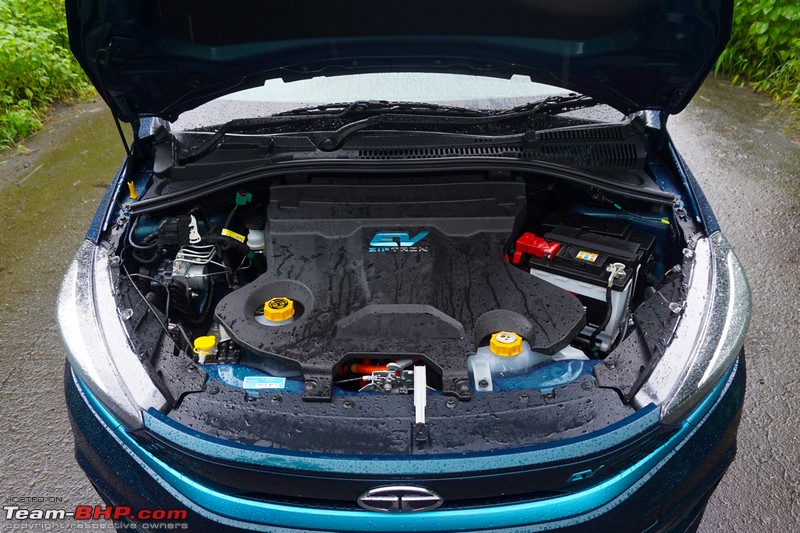 Before we get to the driving part, letís get some basics right. There are 3 main components in an EV Ė the battery, the motor and the controller/charger. The battery is what stores the energy and the motor is what uses that energy to move the car. The controller/charger converts the energy from the battery into a usable form to power the motor. In more technical terms, the power grid from your house or a charging station is usually an AC current. The lithium-ion battery can store electric energy in DC form. So while charging, thereís usually an AC/DC converter that will convert the power grid's AC into DC and store it in your carís battery. The DC fast chargers that you see usually have the AC/DC converter inbuilt, which is how they can charge your carís battery faster. The controller typically sits on top of the motor. In the case of the Tigor EV, the controller and motor are placed under the bonnet. Now, letís get to the driving part. Most of us are still getting used to the eerie silence of EVs after pressing the start/stop button. But it takes just a couple of drives to feel comfortable with it. "Start" the car and its digital speedometer goes all the way up to 160 km/h, then dropping back to 0. There are 4 transmission modes to choose from Ė D, R, N and S. ĎDí mode is more designed for city driving conditions, while ĎSí mode is when you want that extra power (at the cost of FE, which in this case is the battery charge level). We sure wish there was a "P" (park) mode like the Hyundai Kona & MG ZS EV which would lock the wheels in place. Right now, your only option is "N" with the handbrake. Tata should fix this in its future EVs. As a safety feature, the car will always start in "N" mode. Engage D, take your foot off the brake pedal and the Tigor EV gets off the line in a perfectly smooth manner, crawling at 6 km/h. Itís very linear and without any jerks. With 170 Nm of torque available from 0 rpm, Tata claims that the Tigor EV has a maximum restart gradeability of 29-degrees. Meaning, the car can crawl forward from a standstill on an incline of up to 29 degrees with ease. Driving around in "D" mode within the city is a super convenient affair. No clutch, no gears, no turbo lag & no noise means even a newbie driver will seem like a smooth driver. The motor has sufficient torque, but it is used conservatively in "D" mode for a smoother driving experience & to maximise driving range. Think of "D" being more like "ECO" mode. Performance in D mode is decent, but that's it. You wonít have any issues keeping up with city traffic & power is sufficient for day-to-day commuting. When you want to suddenly accelerate from say 40 - 50 km/h though, you will feel the power deficit & it feels like a 1.2L NA petrol! If you want quicker acceleration, simply switch to "S" mode and youíll notice a BIG difference in the way the power is put down. Throttle response is much sharper and you get a stronger surge of power. Added bonus = in "S", you'll see the power gauge on the left showing a redline at the limit (via 3 red bars), just like a conventional rev counter. Out on the open road, D mode is adequate for regular drivers. You can cruise comfortably on the expressway. However, if you need to execute an overtaking manoeuvre quickly, S mode comes in handy. You'll also find yourself engaging "S" mode whenever you are in the mood for some fun. The Tigor EV feels peppy in Sport mode, even on the open road. Power is delivered strongly till 100 km/h, after which it starts to taper off. The Tigor EV's top speed is limited to an indicated 122 km/h (GPS showed 116 km/h) and progress from 110 - 120 km/h is quite slow. Must add that electric cars aren't good at high-speed cruising, from the range point-of-view. Drive continuously at 110 - 120 km/h in "S" mode and you'll see the battery level drop alarmingly fast. That's one of the reasons you'll see most EVs driving at 80 - 90 km/h on the expressway in the middle lane. Regenerative BrakingUnlike some other EVs like the Hyundai Kona or MG ZS EV, you cannot adjust the level of regenerative braking in the Tigor EV. That sucks as we'd like the option to select, depending on the driving condition or individual preferences. Thereís just one standard level of regenerative braking and it is quite mild compared to other EVs. Tata says they have kept it mild based on feedback from Nexon owners and for a smoother drive experience. Canít argue with that; regen does take getting used to, especially if it's aggressive. Tata has provided a regen meter on the instrument cluster with 6 bars to show you how much energy you are regenerating. The maximum regeneration that we saw under heavy braking is 4 bars worth. Again, we really wish Tata gave adjustable regen levels in the Tigor EV, as enthusiasts who like engine-braking in ICE cars usually prefer the higher regen settings. On the highest setting, you can also do one-pedal driving in many situations. Plus, aggressive regen can be used to maximise range. Noise, Vibration & Harshness (NVH)Well, thereís no engine noise for starters! The only sound coming is a faint whirring by the electric motor. No gearshifts & minimal mechanical parts mean no jerks or vibrations. On the highway, tyre noise starts creeping into the cabin early at 80 km/h. You'll hear it more because there is no engine sound to drown some of it out. RangeRange anxiety is a big concern with EVs. However, itís only when you are pushing the car hard that you'll notice the range and battery percentage falling at a rapid pace. The ARAI-certified range for the Tigor EV under standard test conditions is 306 km, but under normal driving conditions, you can expect a range of ~200 km. 200 km is enough for those intending to drive primarily in the city. ChargingTata Motors has been working with its sister company, Tata Power, to improve the charging infrastructure levels. There were about 60 Tata charging stations in January 2020. The number has grown to 640 this August. That said, we can tell you that the best place to charge your EV is at home. Cheapest + most convenient. At an average cost of Rs. 8 per unit, youíll be paying Rs. 208 for a full tank at home. The Tigor EV gets a CCS Type 2 charging port, which is currently the standard for electric vehicles in India. The estimated charging time from 0-80% from a 15A plug point is about 8 hours & 45 minutes. A 25 kW DC fast charger can charge the batteries to 80% in 65 minutes. For a DC fast charger, you will have to pay ~Rs. 18-20 per unit. So a full tank would be Rs. 520 in just over an hour. Ride ComfortThe Tigor EV gets a MacPherson strut suspension at the front and a twist-beam dual-path strut suspension at the rear. It rides on 14-inch rims shod with 175/65 section tyres. The recommended tyre pressure rating is 33 PSI at the front and 38 PSI at the rear. This makes sense as the battery pack has been placed directly above the rear suspension. Like most fossil fuel cars converted to electric, the Tigor EV's suspension has been stiffened up due to the heavy battery pack it is carrying. You'll notice the firmer suspension as soon as you start driving the car. Over some mildly uneven roads in the city at slow speeds, there is a fair bit of movement in the cabin and it even feels jiggly at times. You feel more of the road in the Tigor EV, but still, ride quality is liveable & compliant enough on most city roads. It's only the really big bumps that come in strong, as do the sharp road dips. On the other hand, the Tigor EV rides rather flat on the expressway. Handling & DynamicsThere are a couple of things that aid the handling characteristics of the Tigor EV. Firstly, itís the firmer suspension and secondly, the heavy mechanicals (battery pack + motor) that lower the centre of gravity. High-speed stability is very good and youíll be doing 110 - 120 km/h on the expressway without feeling nervous at all. Get on some twisty roads and youíll appreciate the stiffer suspension. The car feels agile and you can carry good speed into corners. The suspension setup does complement the chassis well and the Tigor EV holds its line nicely by family sedan standards. Changing direction on back-to-back corners is no problem either. Earlier, I had apprehensions that the heavy battery pack at the rear might cause some imbalance, but we didn't face any problem on our (admittedly) limited test drive. The only issue is the 175/65 section rubber which is meant for maximizing range and not for pushing hard into corners. On a particularly wet day outside Mumbai, the only factors keeping us from driving the car aggressively on curvy roads were the tyres and the alarmingly fast depletion of the battery charge! Yes, the battery level drops rapidly if you drive like a BHPian. SteeringThe electric power-assisted steering is a nice unit and is super light at parking speeds. The turning radius of 5.1m is user-friendly and you can manoeuvre the car easily with gentle inputs on the steering. It weighs up adequately as you gain speed. However, the EPS is dead and thereís not much feel or feedback from it. BrakingThe Tigor EV gets disc brakes at the front and drum brakes at the rear. Their performance, in general, is satisfactory. However, we feel that wider tyres would definitely improve the braking performance of the car. Another sore point is that, like most EVs, the brake pedal has a spongy & rubbery feel. It feels weird at first. Last edited by Aditya : 8th September 2021 at 09:01. |
| |  (49)
Thanks (49)
Thanks
 |
| The following 49 BHPians Thank Omkar for this useful post: | Aditya, AdityaDeane, Akshay6988, aman9393, amit_purohit20, Arnav Vaghela, ashis89, Autocaptive, Balaji31582, CARDEEP, CEF_Beasts, chinmaypillay, Chrome6Boy, condor, cool_dube, dailydriver, digitalnirvana, drstrange, Dry Ice, FloatingCanvas, Gaboonviper04, GTO, Hariz066, hemanth.anand, InterceptorGuy, jailbird_fynix, landcruiser123, lemedico, luvDriving, Malluspec, mh09ad5578, NirmalK, PearlJam, PM - B, Punatic, S.MJet, sajaijayan, Samfromindia, Scarlet_Rider, SnS_12, Sreejith V, SulemanP, swiftnfurious, theexperthand, The_Outsider!, turbodude, vb-saan, Vinod_nair, YD14 |
| | #3 |
| Team-BHP Support  Join Date: Apr 2016 Location: Mumbai
Posts: 1,813
Thanked: 21,569 Times
| Tata Tigor EV Exterior ImagesThe Tigor EV is based on the Tigor Facelift and gets a few changes to the exterior that announce it as an electric car. Changes to the front include a different grille and air dam design:  The rear hasn’t changed much even from the original Tigor. Changes include redesigned tail-lamps, a tweaked bumper & no tail-pipe  : : In profile, the 14-inch wheels shod with 175/65 section tyres look a size too small on the Tigor EV, especially since the regular Tigor XZ+ variant gets nice-looking 15-inch alloy wheels. But then, because the suspension has been firmed up, these 14-inchers + taller sidewalls are better from the ride quality POV than the 15s: 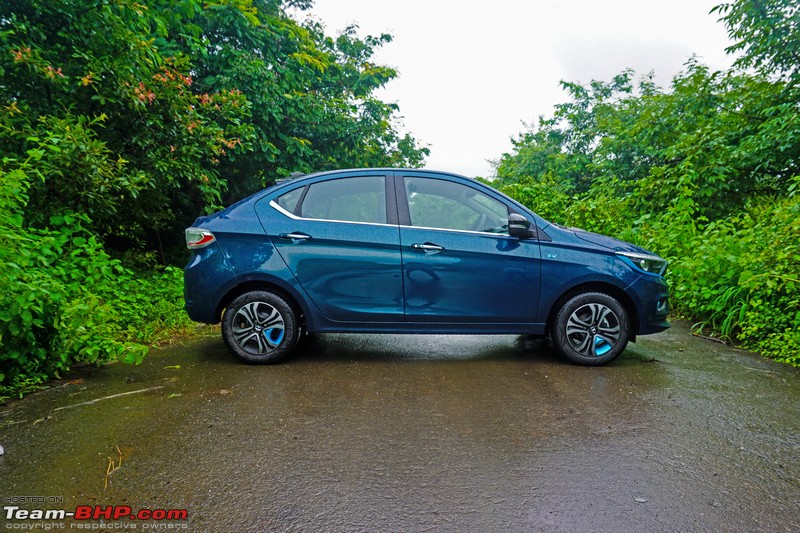 The Tigor EV measures 3,993 mm in length, 1,677 mm in width and 1,532 mm in height, with a wheelbase of 2,450 mm:  Going electric means the Tigor has put on ~200 kg. The additional weight had to be balanced by a stiffer suspension that has also led to the ground clearance going up by 2 mm (172 mm): 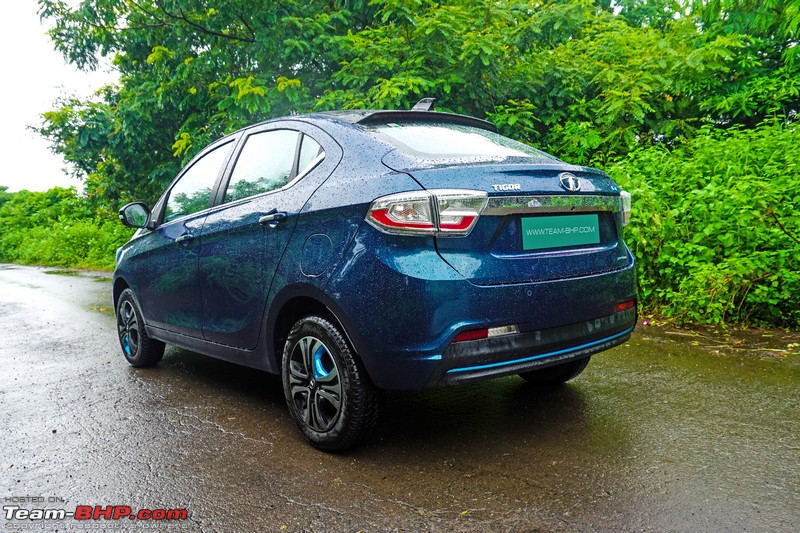 The solid front grille gets a single opening in the middle with the characteristic tri-arrow design at either end. The trim below the grille is finished in blue for the Tigor EV: 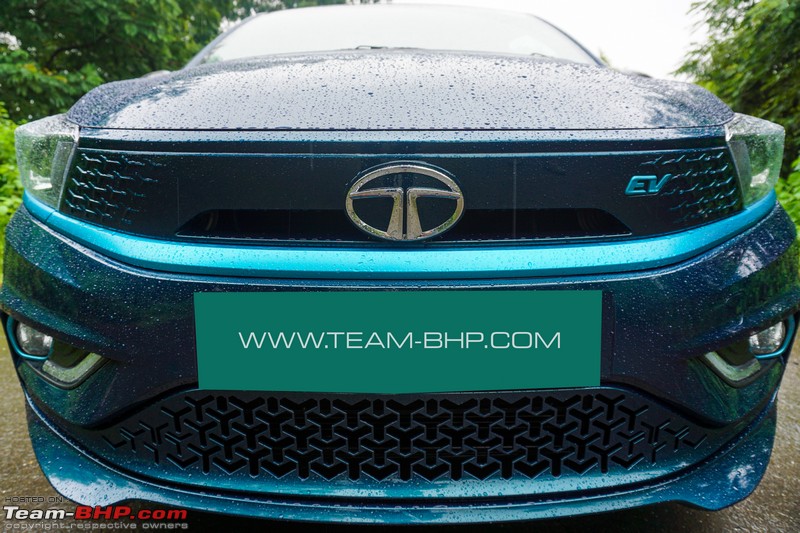 Projector headlamps were introduced in the Tigor Facelift. They’re offered only on the top-end XZ+ variant:  A closer look at the tri-arrow design and the EV badging on the grille:  The air dam at the bottom has a nice mesh-like design with the same tri-arrow detailing. Also, check out the sharp design on the lip: 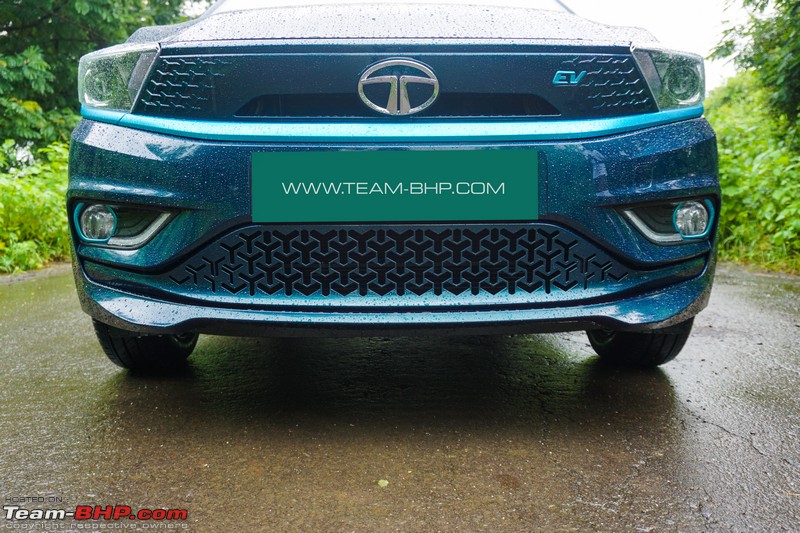 Foglamp housings also get the blue EV touch. LED DRLs are placed next to the foglamps:  The blue insert below the grille was misaligned in our car. Not cool, Tata! You really need to get your build right. The ORVM glasses of a demo that GTO drove were shaking & vibrating on bad roads:  A look at the underbody from the front. Being an EV, we would’ve expected the Tigor to have a healthy amount of underbody protection, but it doesn't:  Plenty of EV badging to let you know this Tigor is different: 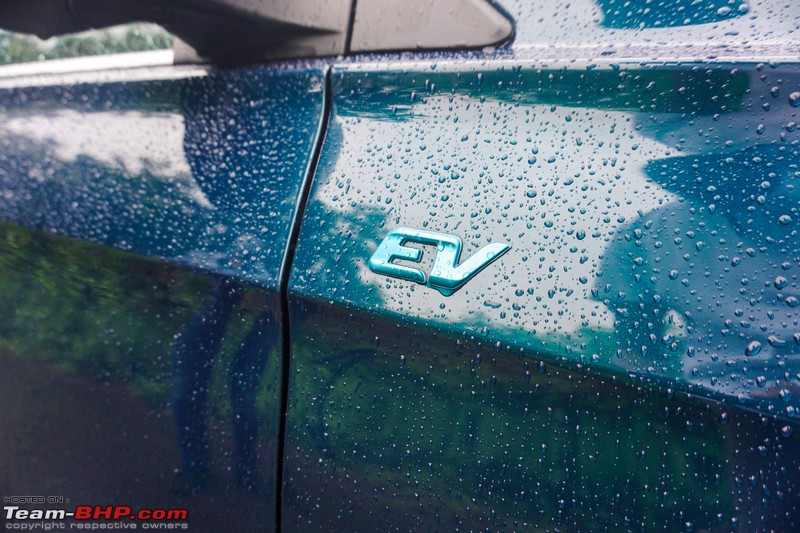 ORVM covers are finished in black for this dual-tone variant:  All 4 door handles get chrome treatment. The driver's door gets a request sensor: 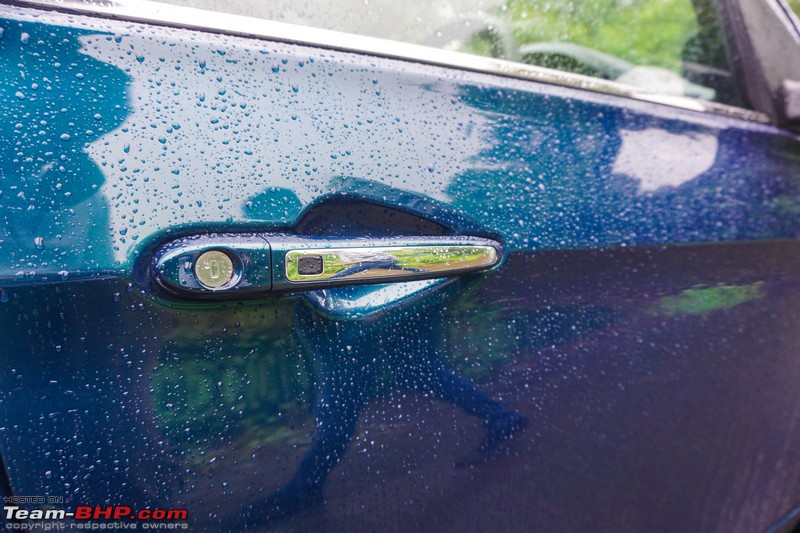 14-inch steel wheels with wheel covers that make them look like alloy wheels. The blue accent on the wheel cover is a neat touch:  The black roof looks great on the Tigor EV; the premium one has to pay for the dual-tone variant is ~Rs. 15,000:  Smart & tight rear. An EV badge on the top right, a Ziptron badge on the bottom right & a blue strip on the bumper will tell you it's the battery-powered variant:  Always loved the design of the spoiler-integrated HMSL of the Tigor. What’s new is the sharkfin antenna on top:  A closer look at the clear lens tail-lamp. Very smart. You get LED elements in the split tail-lamp design:  You get a single reversing light on the left and two reflectors. The light next to the RHS reflector is a dummy. Not done, we wish there were two reversing lights: 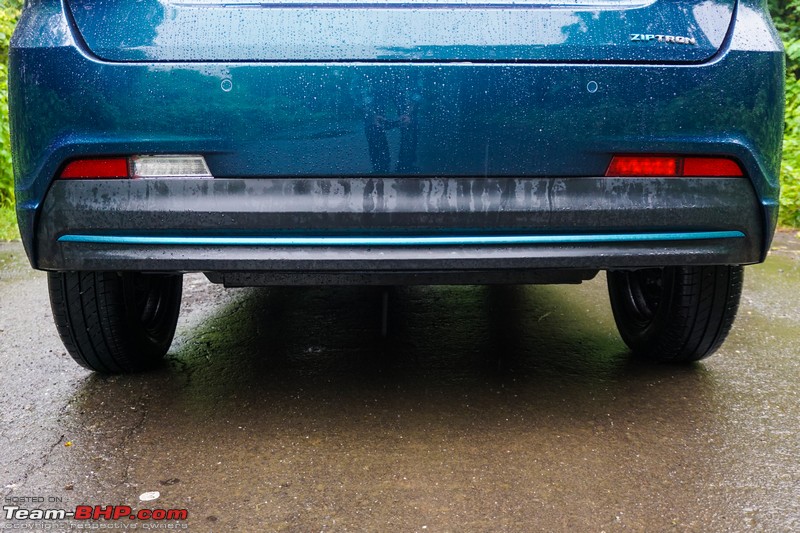 Look underneath and you will see the battery pack, just behind the rear suspension: 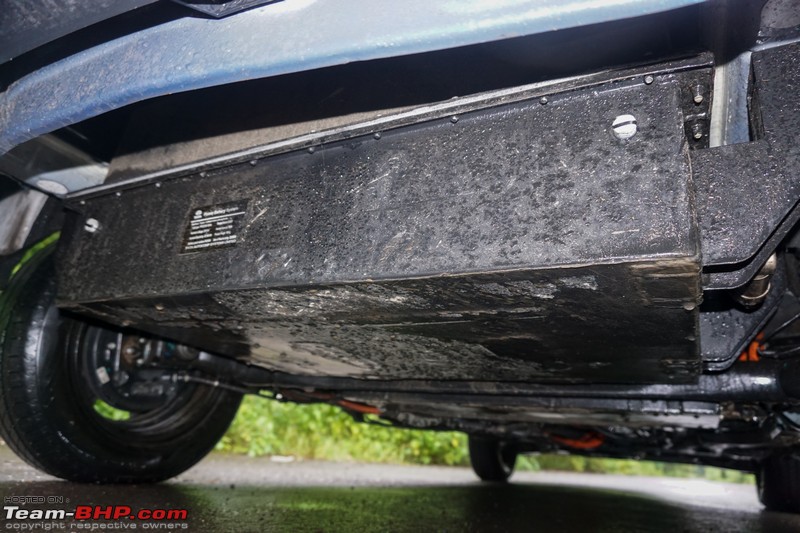 Battery specifications are mentioned on the battery itself. Look at the weight of the battery pack. 165 kilos!  These orange high voltage cables are a sore sight. In road conditions like ours, these wires should definitely have been better protected & concealed:  Last edited by Aditya : 8th September 2021 at 09:02. |
| |  (46)
Thanks (46)
Thanks
 |
| The following 46 BHPians Thank Omkar for this useful post: | 2himanshu, Aditya, AdityaDeane, adityadeva, ads11, aman9393, amit_purohit20, Arnav Vaghela, ashis89, Autocaptive, CARDEEP, CEF_Beasts, chinmaypillay, condor, cool_dube, dailydriver, digitalnirvana, Dry Ice, fiat_tarun, FloatingCanvas, Gaboonviper04, GTO, haisaikat, Hariz066, hemanth.anand, InControl, jailbird_fynix, KuvamBansal, lemedico, Lobogris, Malluspec, mh09ad5578, ninjatalli, PearlJam, PM - B, pmhate, PraNeel, rj22, S.MJet, sajaijayan, Scarlet_Rider, theexperthand, The_Outsider!, turbodude, vnabhi, yesyeswe |
| | #4 |
| Team-BHP Support  Join Date: Apr 2016 Location: Mumbai
Posts: 1,813
Thanked: 21,569 Times
| Tata Tigor EV Interior ImagesWhile the interiors are largely similar to the standard Tigor, there are a few "EV" touches in the cabin. The new flat-bottom steering wheel of the Tigor Facelift is good to hold. Whatís even nicer is that it is soft: 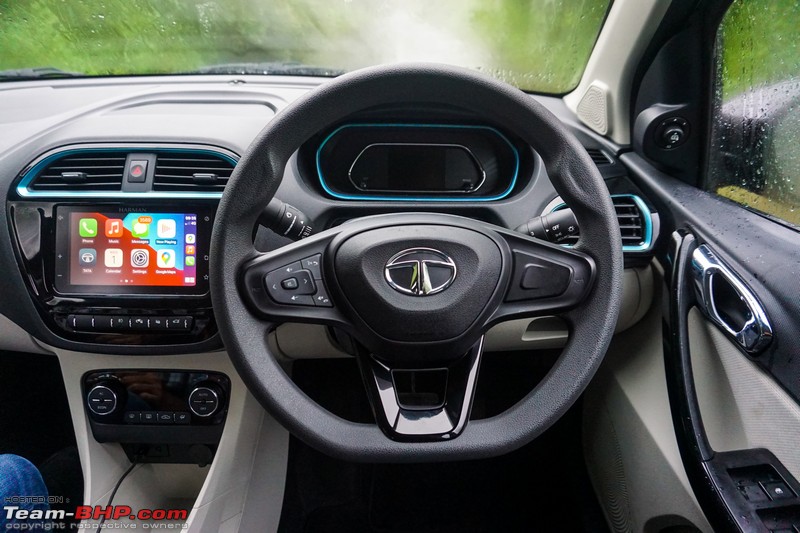 Buttons for the audio system, telephony and voice commands are placed on the left spoke. A useful mute function has been provided (long press to mute). Notice the small horn symbol (next to steering buttons on both sides) - extended horn-pad! The plastic on the spokes doesnít feel very premium. Shouldíve gotten the piano black treatment like in the Tiago NRG (reference image): 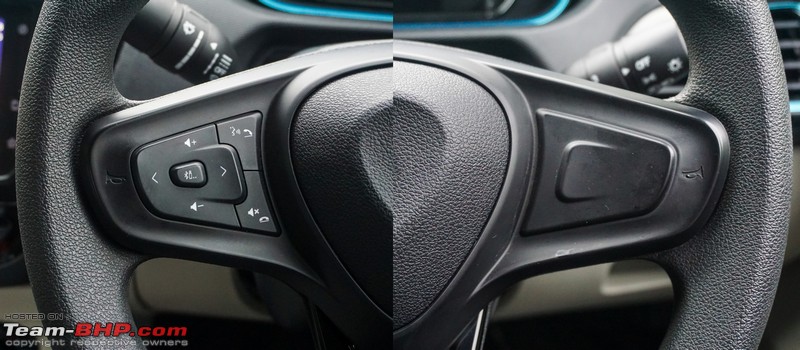 Fully digital instrument cluster gets a blue EV highlight around it. The meter on the left shows how much power is being used (dependent on the accelerator input, similar to an ICE-car's rpm counter). You have a battery level indicator on the top right and below that, you get the Regen meter (6 bars). The screen in the middle displays the speed, charge level, transmission mode, distance to empty etc.:  Air vents get some blue love too:  The dual-tone theme from the dashboard continues to the door pad. The area above the armrest gets a fabric insert which is a welcome touch:  EV-specific seat upholstery gets contrast blue stitching. The driver's seat is adjustable for height:  A closer look at the fabric upholstery: 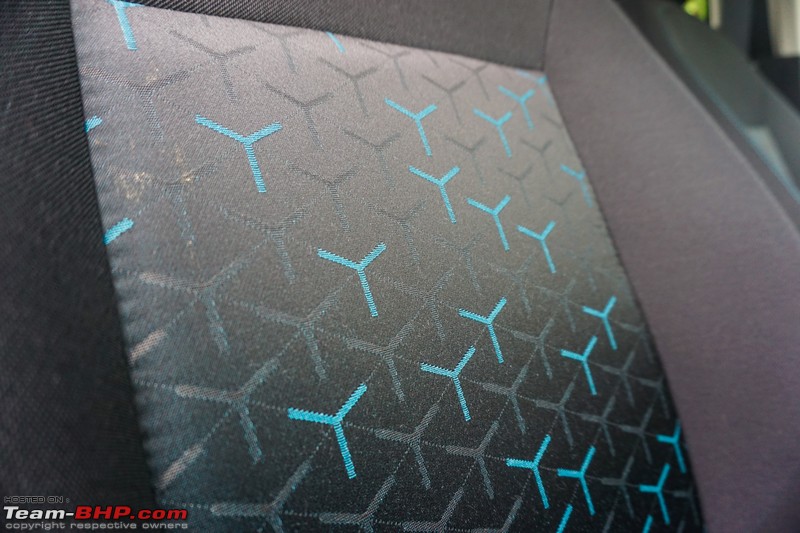 People with a big shoe size might find the pedals placed too close to each other. Pedal travel is on the shorter side. You get a well-sized dead pedal to rest your foot. Notice the exposed wiring above the pedals:  Good to see the "fuel" flap release lever marked properly!!!  The 7-inch Harman touchscreen is basic, yet packs all the features that you would need from a touchscreen. The home screen gets a split display and the touchscreen overall is pretty convenient to use, with very little lag: 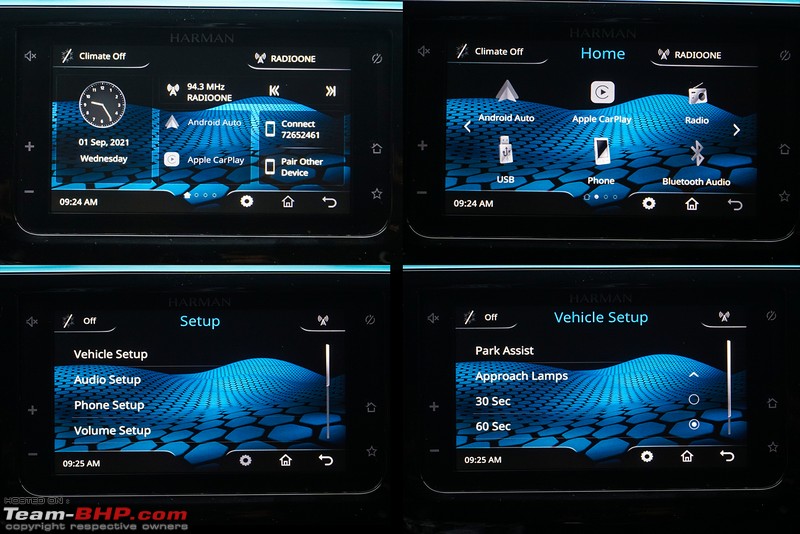 The car gets 4 speakers and 4 tweeters which have the usual audio adjustments. Sound quality is good by compact sedan standards. You also have Android Auto and Apple CarPlay connectivity. Touchscreen doubles up as a display for the reversing camera, which gets adaptive guidelines:  The Tigor EV offers iRA connected car technology, which includes features like intrusion alert, remote immobilization, geofencing, time fencing, remote door lock/unlock, remote cooling, remote vehicle diagnostics, trip analytics etc.:  The button next to the foglamp switch is to lock the charger (to prevent theft). Say you are charging the car overnight in the parking lot, pressing the button locks/unlocks the charger from the port:  The rotary gear shifter has 4 modes - R, N, D & S. We wish there was a "P" (park) mode that would lock the car in place. There is a gap between the desired gear being selected and the drive mode actually being engaged. This will get to you while executing three-point turns:  A look at the rear bench seat with the new upholstery:  With the front seat adjusted to my height of 5'10", I had just about enough legroom. The recline angle is comfortable and the under-thigh support is satisfactory. There are more spacious competitors though:  The 316-litre boot. Spare tyre chews away space. This is without the charging cable in place:  No cladding on the inside of the boot lid. The pre-facelift Tigor had it (reference image): 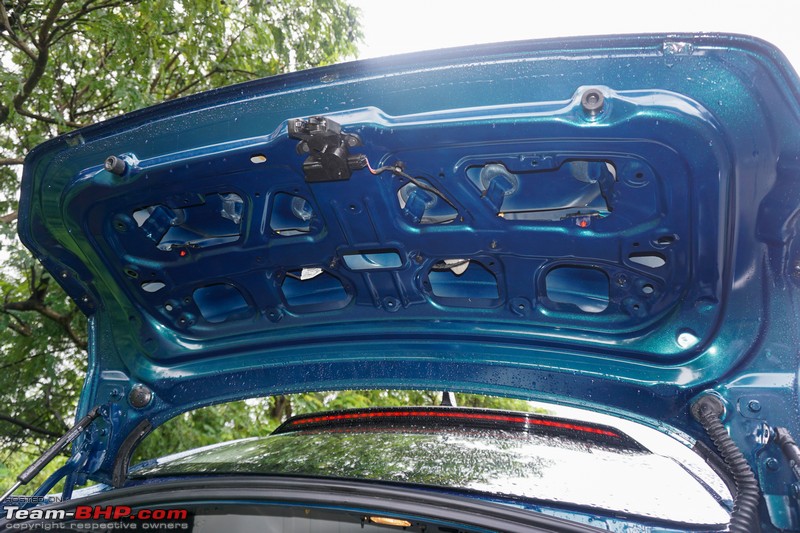 Spare is a full-size tyre (175/65 R14) on a steel wheel:  Lift up the boot floor and you will see the top of the battery pack: 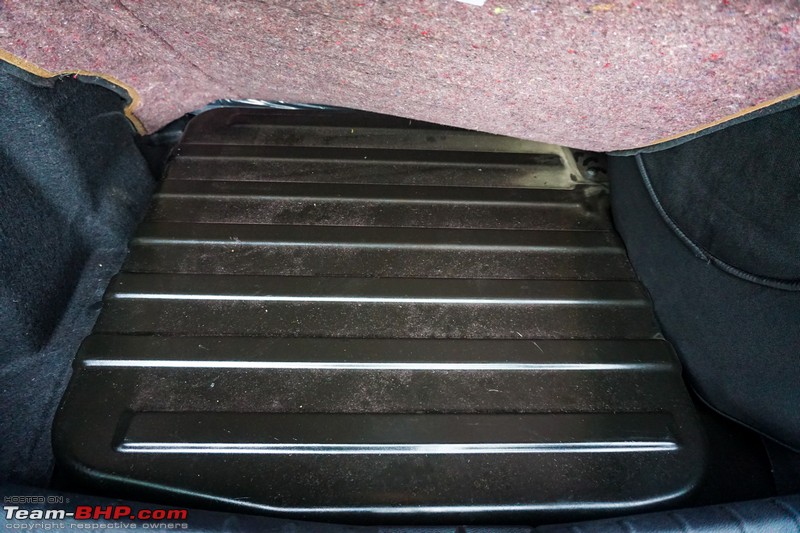 Last edited by Aditya : 8th September 2021 at 09:03. |
| |  (39)
Thanks (39)
Thanks
 |
| The following 39 BHPians Thank Omkar for this useful post: | 2himanshu, ach1lles, Aditya, AdityaDeane, aman9393, amit_purohit20, Arnav Vaghela, AROO7, ashis89, ast.ggn, Autocaptive, CARDEEP, CEF_Beasts, chinmaypillay, Chrome6Boy, dailydriver, digitalnirvana, drstrange, Dry Ice, FloatingCanvas, Gaboonviper04, GTO, hemanth.anand, InControl, jailbird_fynix, lemedico, mh09ad5578, PM - B, pmhate, PraNeel, rj22, S.MJet, sajaijayan, Samfromindia, Scarlet_Rider, theexperthand, The_Outsider!, turbodude, Vinod_nair |
| | #5 |
| Team-BHP Support  Join Date: Apr 2016 Location: Mumbai
Posts: 1,813
Thanked: 21,569 Times
| We visited the Tata Power charging station at the Tata dealership in Nerul, Navi Mumbai. There were CCS + CHA charging ports. The CHA type charging port was used for the previous Tigor EV. The current generation of EVs (Nexon & Tigor) use the CCS type 2 charger:  Hereís a look at the plug for the CCS type 2 DC fast charger:  To charge the Tigor EV, youíll have to install the Tata EZ Charge app. The app displays all the charging stations close to you. When you tap on a particular station, it will show the type of charging ports available at the station. Once you have selected the station, you can choose the type of charging Ė amount, units of charge, time for a charge & percentage of the charge. The app will then show the amount you have to pay. You can plug in the charger and wait. The overall process is quite easy and even a first-time user wonít have any issues navigating through the app: 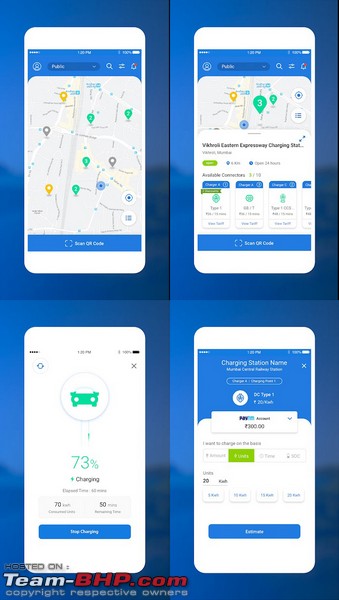 The 25 kW DC fast charger at a Tata Power unit takes ~65 minutes to charge the battery from 0-80%. At a Tata Power unit, a unit of charge (kWh) costs Rs. 18. Some third-party charging stations charge up to Rs. 20 for the same. That's far more expensive than charging at home. The unit displays how much time is left according to your selection of units:  A blue indicator light comes on when you plug in the charger, and a green indicator starts glowing when the charging begins:  The 15A charger that you get with the car takes ~8 hours and 45 minutes to charge the batteries from 0-80%. Best to charge it overnight (at home) or when parked at the office (during the day): 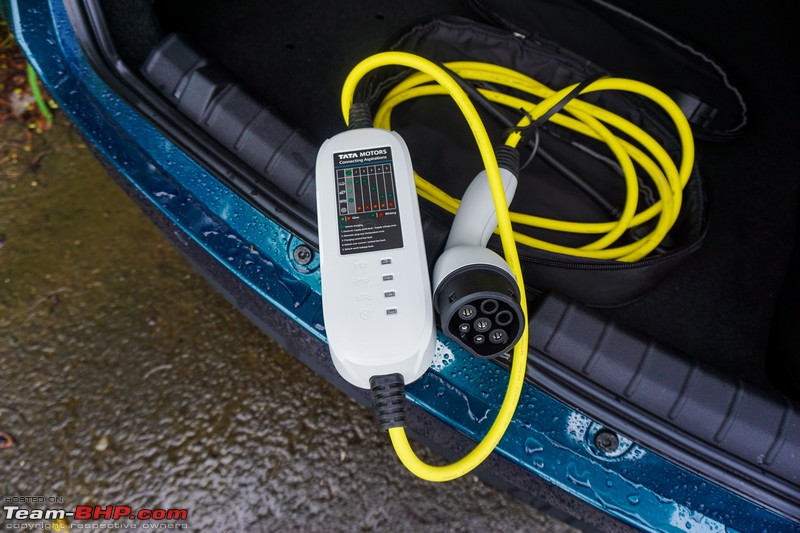 Last edited by Aditya : 8th September 2021 at 09:03. |
| |  (62)
Thanks (62)
Thanks
 |
| The following 62 BHPians Thank Omkar for this useful post: | 2himanshu, ach1lles, Aditya, Arnav Vaghela, ashis89, ast.ggn, Autocaptive, AYP, B_Pranav, CARDEEP, catchjyoti, CEF_Beasts, chinmaypillay, Chrome6Boy, condor, cool_dube, dailydriver, darklord, digitalnirvana, discoverwild, Dry Ice, dr_petrolhead, fiat_tarun, FloatingCanvas, Gaboonviper04, gopaneel, GTO, hemanth.anand, InControl, JithinR, knightrider_7, K_Drive, lemedico, Living2Drive, luvDriving, Macfreak7, Malluspec, mh09ad5578, ninjatalli, PM - B, pmhate, PraNeel, Punatic, r0nit7, Raahil_23, RoadSurfer, S.MJet, sainyamk95, sajaijayan, samabhi, Samfromindia, Scarlet_Rider, Sivacar, SnS_12, srikanthmadhava, sri_tesla, Sumer, theexperthand, The_Outsider!, turbodude, vvivek85, VWAllstar |
| | #6 |
| Team-BHP Support  | The Tigor EV was better than I expected. The on-paper stats had me believe that it will be underpowered, but that's not the case. While the drive in D is ordinary (it's more like ECO mode or a 1.2L NA petrol), "S" was sufficiently peppy. I had a good long drive on the highway. "D" should easily give you about 200 km range which is sufficient for a city commuter, but with a heavy foot in "S" mode, I took the range down from 228 -> 80 km after driving ~110 km. I'm very proud that Tata has snatched the first-mover advantage away from Mahindra, and is selling this world-class technology at attainable prices while Maruti sells 20-year old 4-speed AT gearboxes, Honda still keeps harping about its "Yo Vtec" technology from the 1990s and VW-Skoda couldn't even make their 1.5L Diesel BS6 compliant. In the midst of these outdated / lazy approaches comes Tata offering cutting-edge tech  . . There is a certain sense of pride driving a green number-plate car & other road users do respect you. No denying the camaraderie among EV owners either. Came across this Nexon EV and all of its occupants excitedly waved at me as if I'm a long lost cousin. They were driving @ 80 kmph in the middle lane (to maximise their range), while I was continuously at 110 - 120 kmph in "S" mode.  Last edited by GTO : 8th September 2021 at 09:20. |
| |  (134)
Thanks (134)
Thanks
 |
| The following 134 BHPians Thank GTO for this useful post: | 2himanshu, aarnav_b, ach1lles, Aditya, adityadeva, AkMar, Akshay6988, Almoral, amalji, aman9393, amit_purohit20, amol4184, anandhsub, anthusiast, arjab, Arnav Vaghela, AROO7, ArTigor, ashis89, ashvek3141, ast.ggn, Autocaptive, Balaji31582, batladanny, Big Smoke, Big_Turbo, blackwasp, brownkaiser, Capricorn, CARDEEP, catchjyoti, CEF_Beasts, chinmaypillay, Chrome6Boy, condor, cool_dube, corvus corax, createrkid, deepakhon, Deepsp, DevilzzzzOwn, digitalnirvana, Doge, DriverNo.420, Dry Ice, dr_petrolhead, electro-monk, evil_grin, FloatingCanvas, frankmehta, FrozeninTime, Gaboonviper04, Geo_Ipe, gopaneel, gururajrv, HammerHead, Harjot37, hdman, hemanth.anand, Hemantteen, iamitp, icar, inclmal1, InControl, JithinR, kiran_aithal, klgiridhar, KuvamBansal, K_Drive, lemedico, luvDriving, lxskllr, Macfreak7, Malluspec, Meph1st0, mh09ad5578, museycal, myavu, ninjatalli, NirmalK, Od1um, Osteon206, PearlJam, ph03n!x, PM - B, pmbabu, pmhate, Prafful_Rathod, Punatic, punto_, quantobigboot, r0nit7, RaghuVis, Rajeevraj, ramnaresh_2000, red_nemesis, RoadSurfer, RR96, rrsteer, rsjagtap, S.MJet, sainyamk95, sajaijayan, samabhi, Samfromindia, Scarlet_Rider, Seenz, sierrabravo98, Sivacar, sks2610, skyocean, SnS_12, SoupRaw, srikanthmadhava, sri_tesla, starter, Storm2.0, SulemanP, sumeethaldankar, Sumer, superguy282, Thar4x4, TheCatalyst, theexperthand, The_Outsider!, TorqueIndia, turbodude, varunswnt, Varun_HexaGuy, vnabhi, vvivek85, warrioraks, yesyeswe, Zen_forever |
| | #7 |
| Senior - BHPian Join Date: Feb 2005 Location: Melbourne
Posts: 4,376
Thanked: 5,105 Times
| Re: Tata Tigor Electric Review Excellent review as always. Do we know if the battery is water cooled? The more ideal the temperature of the battery pack, the better it is for long term. As it stands, the long term battery degradation is still an unknown for Tata. Was the range with A/C on? And if it was, what was it with the A/C off, if checked? |
| |  (3)
Thanks (3)
Thanks
 |
| The following 3 BHPians Thank extreme_torque for this useful post: | Akilan902, Carpainter, pmhate |
| | #8 |
| Distinguished - BHPian  Join Date: Nov 2013 Location: HR51/HR29/HR26
Posts: 2,741
Thanked: 21,161 Times
| Re: Tata Tigor Electric Review I think this is a desperate attempt to flog a dead car and in meantime, grab eyeballs and attention while the actually relevant Altroz EV gets ready. Tigor wasn’t anyone’s favourite child to begin with. And nobody is going to touch a Tata car which Tata itself sells as a taxi. The product may be decent in isolation but it’s a Tigor at the end of the day. A 7-8 lakh rupee car priced in the WagonR-Swift-Ignis range. Who is going to buy a Tigor for 13L? Last edited by Shreyans_Jain : 8th September 2021 at 09:51. |
| |  (6)
Thanks (6)
Thanks
 |
| The following 6 BHPians Thank Shreyans_Jain for this useful post: | adityadeva, Mohitkumaar, Nikhil Beke, Sran, Thilak29, TorqMaster |
| | #9 |
| Distinguished - BHPian  | Re: Tata Tigor Electric Review What a wonderful review. Rating it five stars. Excellent to see Tata make such a fast move (compared to their peers) in the EV space. Tells a lot of their focus and how they are definitely trying to have the first mover advantage before Tesla (and probably the rest of the global players following them) drops in India to take the premium EV section. Which probably will be a lot of the initial customer base of Tata EV cars. ------------------------------------ As for the review, request a few more areas to be considered wrt to such EV reviews if possible. I can think of a few below - probably other potential buyers could chip in further - a current view on the charging network. Would be extremely useful to folks like me who are and will be on the fence for the next few years to understand how the manufacturer based and 3rd party charging infrastructure is developing - Potential niggles and worries wrt to EV wear & tear. Those exposed wiring (especially under the car) feel a bit more dangerous wrt to external elements - say rat biting. What would be the potential scenarios of such cases - just a non-working car or even more damage/risk? Does the EV car warranty cover such scenarios given we no longer have a ICE engine under the hood now? - Any views on additional insurance cover. ICE cars would have engine cover (or similar terminology) to provide additional cover to what's under the hood. Do we see (or foresee) anything like that for the battery setup other than the warranty? Are there any clauses that an insurance policy needs to cover over the standard manufacturer warranty? |
| |  (8)
Thanks (8)
Thanks
 |
| The following 8 BHPians Thank ninjatalli for this useful post: | adityadeva, Carpainter, dailydriver, digitalnirvana, FloatingCanvas, Gaboonviper04, Karthik Chandra, sainyamk95 |
| | #10 | |
| Senior - BHPian Join Date: May 2013 Location: Mumbai
Posts: 1,517
Thanked: 6,049 Times
| Re: Tata Tigor Electric Review Quote:
With Nexon, Tigor and Altroz done, I foresee that the Harrier will be next car to get the EV Treatment. Safari will most probably not get it as a limited range EV really doesnt resonate with the explorer nature / positioning of Safari. Go Tata! Also, anyone has the on-road pricing list for different states? This subsidy thing is really difficult to grasp currently (due to lack of awareness). | |
| |  (15)
Thanks (15)
Thanks
 |
| The following 15 BHPians Thank 2000rpm for this useful post: | adityadeva, Akshay6988, amit_purohit20, AutoNoob, B_Pranav, digitalnirvana, Dry Ice, FloatingCanvas, InControl, Karthik Chandra, mallumowgli, Punatic, sainyamk95, skyocean, warrioraks |
| | #11 |
| BHPian Join Date: Aug 2021 Location: UP32,HR26,MH12
Posts: 279
Thanked: 943 Times
| Re: Tata Tigor Electric Review Excellent review covering all the details. Tigor EV does not makes much of a sense as Nexon EV is sitting just a couple of lakhs away with a perceived better range. Also what Tata could have done is priced Tigor at starting 9L which could have translated it into an affordable option compared to Nexon. But kudos to Tata for atleast giving decent offerings in electric range as well. I wonder where they would pitch in the Altroz EV if Tigor is priced at 11.99L. There are also rumours of Altroz getting more range than even Nexon. |
| |  (3)
Thanks (3)
Thanks
 |
| The following 3 BHPians Thank tsi_niks1989 for this useful post: | FloatingCanvas, InControl, lemedico |
| |
| | #12 |
| Senior - BHPian Join Date: Oct 2007 Location: Seattle/Pune
Posts: 1,216
Thanked: 4,902 Times
| Re: Tata Tigor Electric Review Good. Feels like a trailer for better things to come! Altroz will be real deal. Hope they stick in same powerplant as Nexon in it and don't treat it step-motherly. Also great move by Tata. By the time others come up with affordable, main stream EVs like what Tata has - Tata's long term reliability (hopefully) of EVs would already be established. Last edited by amol4184 : 8th September 2021 at 10:15. |
| |  (1)
Thanks (1)
Thanks
 |
| The following BHPian Thanks amol4184 for this useful post: | mh09ad5578 |
| | #14 |
| BHPian | Re: Tata Tigor Electric Review While we are discussing about the low cost of running for EVs, have we wondered what does it cost to replace batteries at the end of the battery health ? I reckon the total cost of ownership would eventually come up to premium paid initially for EV and the battery replacement cost after few years. If one chooses not to replace battery and sell it off, he may get scrap value for selling an EV without a battery. Dirt cheap running cost "NOT" = Dirt cheap ownership cost. |
| |  (12)
Thanks (12)
Thanks
 |
| The following 12 BHPians Thank slamnos for this useful post: | adityadeva, Akshay6988, Balaji31582, blackstallion76, Carpainter, digitalnirvana, GTO, Karthik Chandra, mh09ad5578, ninjatalli, RoadMonkey, sarav100 |
| | #15 | |
| BHPian Join Date: May 2016 Location: Cochin
Posts: 108
Thanked: 177 Times
| Re: Tata Tigor Electric Review Quote: The Ford Pinto comes to mind which had a similar placement for its fuel tank that ruptured consistently and caught fire when the car was hit from behind. Lithium battery packs are high in energy density and any deformation/impacts can start a fire. It would be nice to know in detail, the kind of protection given to this battery pack by Tata. | |
| |  (5)
Thanks (5)
Thanks
 |
| The following 5 BHPians Thank TT-S for this useful post: | adityadeva, dailydriver, digitalnirvana, frankmehta, GTO |
 |






